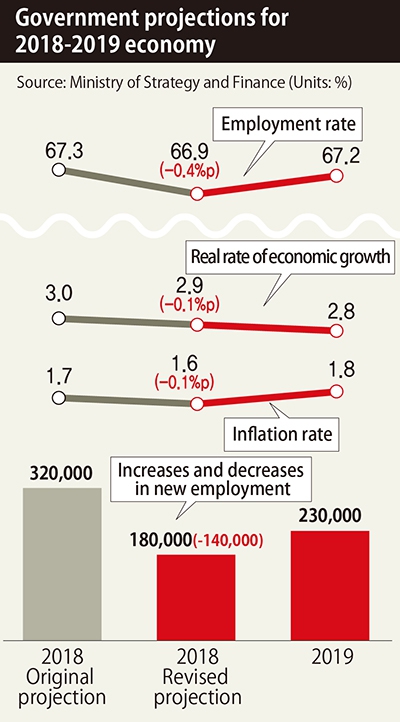Posted on : Jul.19,2018 17:32 KST
 |
|
Government projections for 2018-2019 economy
|
Expected growth rate lowered from 3 percent to 2.9, job growth from 320,000 to 180,000
 |
|
Government projections for 2018-2019 economy
|
As recently as late 2017, the South Korean government was predicting a 2018 growth rate of 3 percent for the South Korean economy. Its decision on July 18 to lower that prediction to 2.9 percent shows its awareness of the serious situation the economy has recently been facing. In particular, it expects the current hiring slump to continue into the second half of the year, drastically lowering its new employment projections for this year from 320,000 to 180,000. Observers are saying the developments make a mockery of the government’s previous assessment of the economy, with its focus on “eight straight months of recovery.”
According to an economic forecast for 2018–2019 published by the administration on July 18, the real growth rates for this year and next year were projected at 2.9 and 2.8 percent respectively. Analysts noted that the goal of achieving growth of over 3 percent for a second straight year after 2017 has been all but ruled out. In addition to the growth rate, projected figures for different individual components affecting the rate were also revised downward. The rate of increase in private consumption was calculated at 2.7 percent for this year, down from a 2.8 percent prediction in Dec. 2017; projections for the rate of increase in facility and construction investment over the same period were respectively lowered from 3.3 to 1.5 percent and from 0.8 to 0.1 percent.
The predicted scale of the current account surplus was reduced to US$64 billion from US$79 billion. With a projected 1.6 percent increase in consumer prices, price stability was expected to continue. Total new employment was lowered by 140,000 from earlier predictions, while the predicted employment rate was reduced by 0.4 percentage points from 67.3 to 66.9 percent.
Slow growth aggravated by US-China trade war and rising oil prices
As reasons for lowering its growth rate predictions, the administration has cited checks on recovery due to the intensifying US-China trade war and rising oil prices, as well as a dropoff in growth for Chinese tourism and a hiring slump. Do Gyu-sang, who heads the Ministry of Strategy and Finance’s economic policy bureau, explained, “Exports and investment have risen amid a trend of improvement in the global economy, but the benefits have been confined to semiconductors and a few other industries.”
“For other industries besides semiconductors, exports have been stagnant and investment has fallen,” Do said.
Indeed, while exports and facility investment respectively rose this year by 6.6 percent (January to June) and 4.8 percent (January to May), industries outside of semiconductors experienced 0 percent growth in exports and -1.4 percent growth in facility investment. Consumption has ostensibly risen, but the kind of domestic consumption capable of stoking demand for the domestic economy has dropped off; consumption categorized as closely linked to domestic demand has actually fallen.
The declines in construction and facility investment are predicted to continue for some time, while employment faces its worst slump since the global financial crisis of 2007–08, with the number of hires coming in at just over 100,000 for five straight months since February. For 2019, the administration projected a growth rate of 2.8 percent - just 0.1 percentage point lower than this year’s – but an increase of 230,000 in new employment.
“The situation this year is bad enough that we couldn’t achieve 3 percent growth even through state spending,” explained Yonsei University economics professor Sung Tae-yoon. “The employment situation is just in too bad a shape.”
But the administration predicted private consumption could rise by as much as 0.2 percentage points, and the economic growth rate by 0.1, through reductions on the individual consumption tax for automobiles and 4 trillion won (US$3.5 billion) in fiscal reinforcement.
“The government’s previous economic forecast was optimistic in its reflection of policy commitment and effects, whereas the latest one is a pure projection that doesn’t include policy effects,” explained Ko Gwang-hee, head of the Ministry of Strategy and Finance’s economic analysis division.
“There is room for the growth rate to rise once the policy effects start to show,” Ko predicted.
By Heo Seung, staff reporter
Please direct comments or questions to [english@hani.co.kr]








